Mongolia 2016
On the second day the tooth was pulled. This is not going to work. We have to revise our plan. The area around Terelj is mountainous, and the roads are a challenge. With full luggage the euphoria quickly vanished. We fear for our material, and sometimes we have to push because it is simply too steep. So we take the Gobi out of the plan as a precaution and win three reserve days.
So much for a little shock at the beginning ;-)
Well, things didn't get that bad after all, and in the end we had a good 1600 km - about 350 km of terrain. But one after the other.
Prehistory
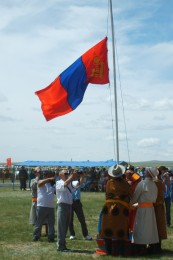
Chuugii, my daughter-in-law, with real name Chunsriimyatav Ganbaatar, was born in Darkhan. This is about 300 km southeast of Ulaanbaatar. To the next asphalt road it is about 100km steppe road. In 2013 we were there for the wedding celebration - and sometimes you get carried away in a "youthful carelessness" or in a euphoric mood to say something you should perhaps keep to yourself: "2024 I cycle from Dresden to Ulaanbaatar". That one is still able to do this, assuming one's health is good, requires some considerations, and it is advisable to first start a test balloon. That's exactly what the bike tour 2016 should be. Two years have passed since the last big tour, and also we, Winfried Bahmann (60, Triebel) and Manfred Rahmig (58, Dresden) have 10 years anniversary. Everything started in 2006 with the trip to Sicily.
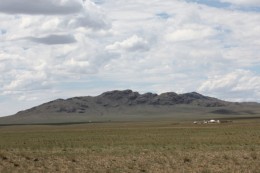
This time the start is not in Triebel, but we fly from Berlin to Ulaanbaatar and try from there to explore Mongolia by bike. As we are not globetrotters by nature, but rather belong to the category of "good German citizens", who always have somehow only limited time and always need a plan to tackle something, the operation becomes a bit complicated. Because "planning" and "Mongolia" don't really fit together - that's what every travel guide says.
Of course you could hire an escort vehicle and a translator, and everything would be arranged, but that's not what we want. Nevertheless, we have a few favourable conditions that make the project predictable:
(1) In case of an emergency, help is available on site. The navigator is with the parents-in-law and his family at the same time and could be contacted by telephone (if there is signal).
(2) Most of the planned route is already known, as I was already on my way in Mongolia in 2013 (as a tourist in an air-conditioned off-road vehicle).
(3) It is long enough time to prepare yourself linguistically. Skills should be sufficient to cope with everyday challenges (organising overnight stays, procuring food, ...).
(4) And then there's GPS, so you always know where you are. Of course the power supply has to be guaranteed, but that shouldn't be a problem for a period of three weeks.
Then there was the idea of having a third man in the group. So far we have done almost all big tours (except Istanbul) as a duo. If you get into an awkward situation, the three of us would be more flexible when it comes to organizing help. Already before Christmas 2015 it was clear that Christian Lattermann (49, Dresden) would support the old men this time.
Preparation
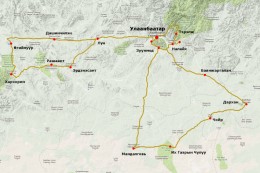
Of course, the plan was finished a year ahead of schedule. That's always the case - somehow it doesn't leave you alone until the last detail of the route has been clarified. Mongolia is about 4.5 times bigger than Germany. So you can't talk about traveling through whole Mongolia. It is primarily about the somewhat wider surroundings of the capital. There it offers itself to drive simply a few loops in all directions. Mandatory stations are Kharkhorin (under Chinggis Khaan the former old capital Karakorum) in the west, Terelj in the green north and Ikh Gazarin Chuluu (translated: big place of stones) in the south, in the Gobi. All stations where I was already an ordinary tourist in 2013.
Then we have to visit Darkhan, where the parents-in-law of my son are living. And then, of course, it would be nice if the Naadam festival was taking place in Darkhan at that time. For three weeks it's a full programme and I'm annoyed that I didn't take a closer look at the quality of the steppe tracks in 2013 under the aspect of cycling. But what I still remember is that you often have the difficulty of choosing the right track to follow. So a navigation device has to be, even if it only serves to calm you down. And when you have that, you can also define the planned stages as routes. This makes everything even easier.
Language is a very important factor. We want to make it without an interpreter and an escort vehicle. The experience of 2013 has shown: You can't get very far with English - and you can't rely on Russian either. If you browse the Internet, it is difficult to find a Mongolian course: My introduction was "Kleiner Mongolisch-Kurs" by Paul Metzler and Enkhzaya Eldevdorj. Later I mainly relied on "Gateway To Mongolian" by D.Baasanjav & M.Solongo, a souvenir from Mongolia 2013. It is important to always have listening examples at hand, because the script is Cyrillic, but the pronunciation has almost nothing to do with Russian. For further questions I still had Chuugii, my daughter-in-law.
Since 2013, German citizens can travel up to 30 days in Mongolia without a visa. Then you still need a flight - if possible without changing planes, because the bikes have to be there, too. From Berlin to Ulaanbaatar you can fly with the Mongolian airline "MIAT". At the moment there is a stopover in Moscow, the total flight time is about 9 hours. The time difference Mongolia - Germany is +7 hours. We wanted to take the bikes with us. This is a relatively expensive affair, however, if already, then also the own vehicle should also be present. The rest of the preparation was the usual, let's give it to ourselves at this point. For information about Mongolia please refer to "Wikipedia" and "www.mongolei.de".
To get some structure into the report, I simply divided it geographically. Starting with Ulaanbaatar, the north, west and south follow.
Ulaanbaatar
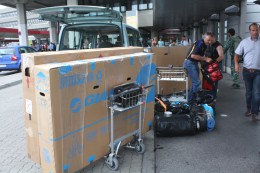
On 2.7.2016 the time has come. We are standing with our three boxes in Terminal C of Berlin/Tegel Airport. The lady at the counter thinks we have flat screens as bulky luggage. So far everything is in the green. We are a bit excited already, but there is someone who will welcome us on site. The Navigator and his family have arrived in Mongolia three days earlier. We fly again with "Chinggis Khaan", that's the name of the Boeing 767-300 ER of MIAT, which was put into service in 2013 and is apparently responsible especially for Berlin - Ulaanbaatar service. Unfortunately, the position display for the passengers is broken this time, but the entertainment program works, the catering is OK, and after a short night we land in the Mongolian capital around 7:30 a.m. The welcoming committee is ready. The bikes survived the flight well and are reassembled, the crates are deposited in the luggage storage - everything ready for the arrival photo.
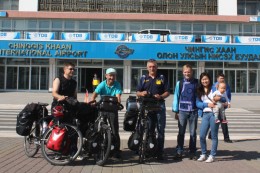
What we still need is a "Mongolian mobile phone" that supports the G-Mobile network. According to the locals, G-Mobile is the network with the greatest possible coverage. We'll get that tonight when we meet again with everyone at the Hotel Mongolia in Gachuurt. Then, the Navigator with family is gone again, now we are on our own.
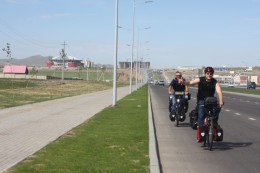
The first thing that stands out in comparison to 2013: A large 6-lane road has been built from the airport towards the city centre. If driving by car was your first adventure in 2013, you now have your own lane as a cyclist, as the total traffic is limited and there is still enough space for everyone.
As a "tour guide" I have planned the following program for Ulaanbaater:
1st Zaisan Hill
2nd Sukhbaatar Square and Parliament
3rd Gandan Monastery
4th get some food and go to the camp in Gachuurt.
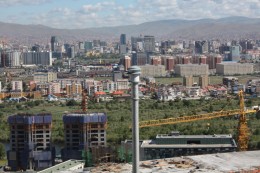
I'm going to spare myself the description of the sights. You can read that everywhere. Maybe just this much: From Zaisan Hill you have a fantastic view of Ulaanbaatar (translated "Red Knight"). Often one simply speaks of UB. Until 1924 the city was known to the Europeans as Urga. The first big houses in the European style were built in the 30s of the last century. This late development is not really noticeable today. Big city is big city. For us there are still no essential differences, everything is relatively familiar. Today about 1.3 million people live in the UB metropolitan area, almost half of all Mongolian inhabitants. The average annual temperature is -2 degrees Celsis. Thus Ulaanbaatar is the coldest capital of the world.
But it's warm today. Also the shopping in the Nomin supermarket works, and we get to feel the normal madness on the Narnii Zam (one of the two main traffic arteries in east-west direction) - we are stuck in a traffic jam.
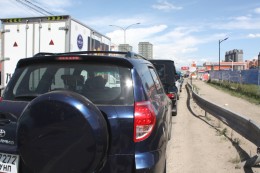
On weekends everybody is allowed to drive, Monday to Friday it goes by number plate - so every vehicle has to stop once a week on one day. The traffic jam is caused by an intersection where the traffic is controlled manually by the police. Somehow our direction is always at a disadvantage. Everyone else gets "green" more frequently. Gradually our side is becoming disgruntled and a horn concert begins, which is clearly addressed to the police. It doesn't take long either, then they give in.
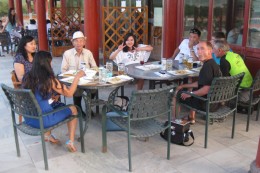
In the evening we meet again at the Hotel Mongolia for dinner. Next door we have moved into a yurt - Mongolian means Ger. Chuugii's uncle, Buyan, leaves us a Mongolian mobile phone. Tomorrow we are on our own.
In the "north" - north of UB
North of Ulaanbaatar lies the Khentii Mountains. Here it is green and real trees grow. The highlight is the Gorkhi Terelj National Park. The first real stage is to get used to it, about 50 km long - it is uncharted territory. We approach Terelj from the west and it goes into the terrain. If you have a GPS, you should look at it from time to time. But I am so sure that it has to go left through the valley.
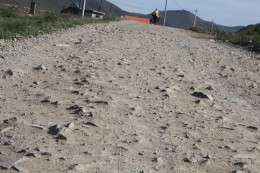
We turn off and come to perhaps the worst "road" of the whole tour. It is a gravel road, but it is so worn out that the stones stick out like rocky peaks. Disillusionment spreads. The tires won't be able to do that for long. And then I see that we are on the wrong way - what luck! So three kilometres back again and to the next valley. The road isn't much better at the beginning, but at some point it changes to a normal steppe track. That works again.
We meet another travel group - also Europeans who also want to go to Terelj. Like us, they are travelling by bike, but at the moment this is in the transporter. They always ride only in sections and of course without luggage. The Mongolian guide tells us something about two passports that will come there. Oh, that surprises us now. Is there such a thing here as well? And indeed. At the end of the valley an ascent begins and the path disappears behind trees on the right. And then it goes steeply uphill.
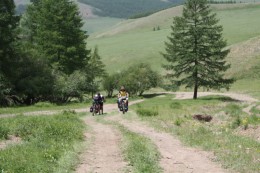
Second low blow today. When sitting, it gets too hard, if you get out of the saddle, the rear wheel turns. Push is probably the easiest thing to do. After finite pushing you can see the Owoo. That must be the saddle of the hill. Owoo, this is the name given to the piled stone piles, which are mostly to be seen in special places (e.g. mountain tops). It is the home of the local spirits. If you want to make them merciful, you should add a stone and circle the Owoo three times clockwise.
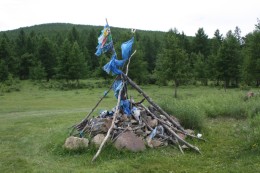
The whole thing repeats itself in slightly weakened form on the second hill saddle. Winfried shows it to the youth and manages it without descending. So we know who the candidate for the overall victory is.  Then it's downhill again. In front of us Terelj. At the first grocery store we have a round "Шaр Aиpaг", yellow Airag - another name for beer in Mongolia. And look there, also our competitors from the jeep arrive, but they stay tough: A beer is not in their program - or they have not earned it.
Then it's downhill again. In front of us Terelj. At the first grocery store we have a round "Шaр Aиpaг", yellow Airag - another name for beer in Mongolia. And look there, also our competitors from the jeep arrive, but they stay tough: A beer is not in their program - or they have not earned it. 
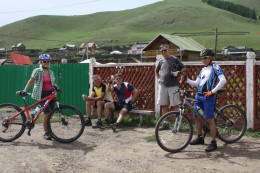
From Terelj to the planned camp there are still a few kilometres to go, but now we have an asphalt road that changes into a gravel road for a short time, when we have to cross a mountain ridge. Another opportunity to push. We have observed this several times: It may be that they don't have the technical means to asphalt steep climbs and inevitably choose the "natural" option. But finally it's done, and we are in perhaps the most beautiful camp of the whole tour at position (N 47.8896, E 107.4239).
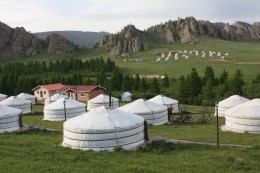
Well - today's stage gives something to think about. We need to revise our plan. The Gobi will be too risky without an escort vehicle. So we'd rather drive on the asphalt road directly to Choir, save three days and have it in reserve. Here it is beautiful. Near the Ger the edelweiss blooms, the rocks form a splendid scenery. We spontaneously decide on a rest day for tomorrow.
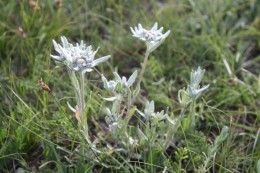
The rest day is bicycle-free, we go hiking. The highlights are Turtle Rock (the turtle rock) and the temple of the princess (monastery and tomb from the 18th century). The latter has an exciting history, but there is not enough space for it. It would have been a pity if we didn't have the rest day.
The way down from Terelj towards Nalaikh is like a dream. The sun is still just above the horizon and the white yurts shine from the green along the valley. The mood is on high flight. Today's destination is Zuunmod, the administrative centre of Tow Aimag. Relative to UB it is located exactly on the other side of the Bogd Khaan Uul. Uul means mountain.
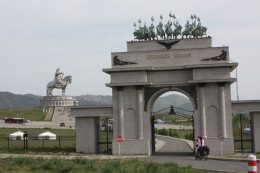
But first we have to go to Tsonjin Boldog's world's biggest equestrian monument. You can't miss it. After crossing the river Tuul you simply take the first turnoff to the east and after about 15 km you will find it in the landscape. It is said that a golden whip of Chinggis Khaan was found here. However, it is impressive. On top of a 10 m high pedestal building rises a 30 m high equestrian statue.
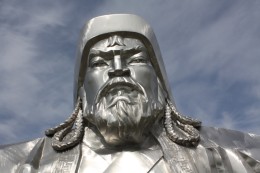
Finest stainless steel, without any signs of aging. It has been here since 2008. The head of the horse is developed as a pulpit and can be entered. Thus one stands eye to eye with the man who united the Mongolian tribes on a large scale and was thus able to establish a world empire. Today, people will certainly think a little differently about the world empire, but different times, different standards and different values.
We have to go back the same road and already notice: The wind has changed. We fight our way through Nalaikh, where there is some dust storm, head south and then turn west. Shortly after Zuunmod we unexpectedly find a small but nice Ger-Camp. Alcohol is taboo here, as it is a family and child-oriented camp. But the boss has a bottle of Grusinian wine in her car that her husband gave her. She sacrifices it for us. We also have camel roast. To be honest, I don't really remember how the camel tasted. In any case, there was nothing wrong with it.
In the "West" - west of UB
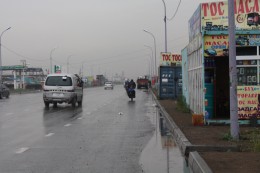
We are heading west. The day begins with rain. We touch Ulaanbaatar again, quickly look past the airport again because of free Internet and then take the road leading to the west. Also here there are three lanes in each direction for a long time. The wind is with us today and after about 160 km Lun comes into sight.
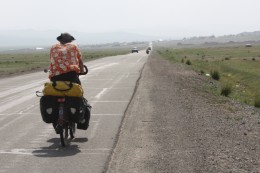
And suddenly there are four of us, because we caught up with Jerome from France. He's a real globetrotter, you can see that immediately, and he's been on the road for 18 months now. In Ulaanbaatar he has applied for a visa for Russia. Since he has to wait two weeks for it, he wants to go to the Khövsgöl Nuur in the meantime. Nuur means lake. He's up to something, because that's pretty far away. Since he is also looking for an overnight stay, we stay together.
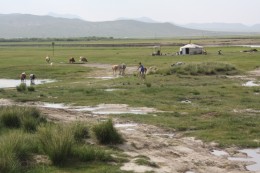
Behind Lun one meets again the Tuul river, which also crosses Ulaanbaatar. There should be a camp here that I had identified in Google Maps in the form of regularly arranged white dots right behind the river. But there is nothing to be seen far and wide. We drive a little helpless on the road back and forth. Then a few children become aware of us.
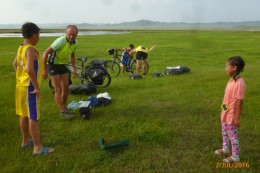
One of them likes my Mongolian flag, and he asks if he can get it. Of course he can. In return, I ask if we can spend the night here and pitch our tent. Of course we can. The parents are not here at the moment, but the girl of the three immediately assigns us a pitch - not too far away from her yurt. We have diligent helpers to set up the tent.
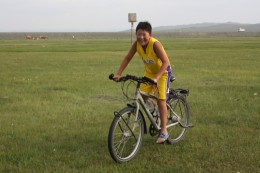
The shower's out today, but we can go into the river. You just shouldn't think about the fact that a few hundred meters upstream maybe the horses are "bathing".
We are a little besieged by the children tonight. They test our bikes and Christian uses the opportunity to play football with them. The parents have also arrived in the meantime. We greet each other from a distance. Everything is going its way.
The next morning it is certain: Germany has lost in the European Football Championship semi-final against France. Jerome is astonished, so are we - but others can also play football. The sun is there from the very beginning today - it's going to get hot. Our goal is Bichigt Khad (meaning "described rock"), also a camp we went to three years ago. Shortly after the start we turn southwest. Jerome takes it easier and starts later. He is not sure yet which way he will take.
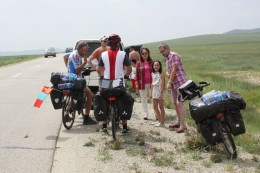
Everybody has their weak day. I get it today. But before there are a few reunions: First we are overtaken by holidaymakers from Leipzig. We had already met them at the equestrian monument. Their tour will soon be over and the last thing on the agenda is Kharkhorin. Some time later the next car stops. A Belgian-Mongolian family we met at Terelj Camp. They are also on their way to the same destination. The thermometer now shows 38 degrees - at least they tell us.
And then I start to get the cramp. The same problem as last year's first stage of the Stuttgart Tour. It comes all along the line - calf, thigh, back, foot, finger. Back then it was over again the next day. That is my hope. But for the moment it looks gloomy. Stop now and then and avoid any jerky movement. It becomes an agony and we can't quite get anywhere.
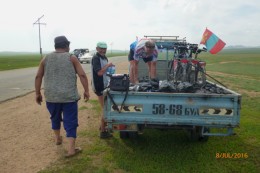
All right - an opportunity to test the Mongolian language skills. At the next yurt near the road I try it. Next to the ger there is a transporter, and a young woman is also nearby. I just ask if they could drive us to the next camp. Apparently she understands me and is looking for the boss who is resting in the yurt. Well - if we pay, he would do it. In no time at all everything is charged, the boss sits at the wheel, takes off his sandals - because it seems to be better to drive barefoot - and off we go. After about 20 km the goal is reached. Well, that's how it works. For tomorrow we announce another rest day.
The rest day begins as a rest day, the weather is also not so great. It is rainy. But at some point it has to start. Christian and Winfried drive 10 kilometres back to Rashaant to go shopping. For me the rest day still lasts a little longer.
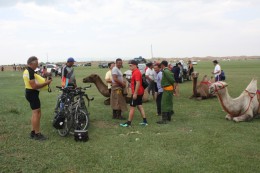
Near Camp Bichigt Khad there is a large sand dune and the National Park Khogno Khan Uul. Where there is sand, camels are not far away, and you can ride on them. Also a memory of 2013. Of course this has to be included in the program - by bike (this time without luggage) everything is reachable in finite time. Well, camel riding is camel riding, you don't have to say anything about it.
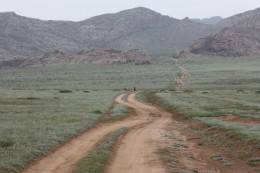
The Khogno Khan Uul National Park is more interesting. Up to there it is about 10 km of steppe and you have to cross a small mountain ridge. From above you have a magnificent view over the country. Not visible from the path, a valley opens later that leads to the monastery Erdene Khamb. Also here we were three years ago. But for today it is enough for now. Christian still makes the side trip to the monastery, we meet again later in the camp.
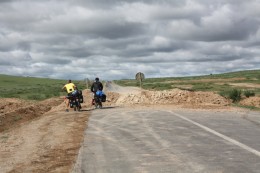
From Bichigt Khad to Kharkhorin it is approx. 130 km, for asphalt road actually a normal stage length. But now the wind comes from the west. That makes it difficult. In between a typical Mongolian road construction site - by the way the only one of the tour. In 2013 there was more of it. The road is closed by dumping a few loads of soil and digging a trench along both sides of the road. Vehicles are thus forced to drive alongside the road - no problem in the steppe. Of course, you can easily overcome the barrier by bicycle. The compacted gravel is at least so good that we prefer it to the steppe road.
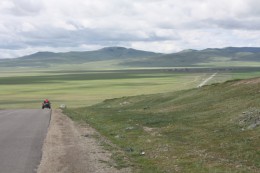
The first glance into the Orkhon valley remains in the memory. Here already in the 8th century Turkish tribes settled, and here Chinggis Khaan later gathered his troops. Under his rule in 1220 Karakorum (today Kharkhorin) became the first capital of the Mongolian empire. Of course there is not much to see of the river Orkhon, it rather has the character of a somewhat larger brook. This must have been different in the past. To Kharkhorin (which translated means "black mountains") it is then still 16 km. The walls of the Erdene Zuu monastery are visible from far away.
In 1586 three temples were built here under the Khalkha Prince Abadai to give three Thankas (scroll pictures), a gift from the Dalai Lama, the worthy home. This is generally regarded as the beginning of the conversion of the Khalkha Mongolians to Tibetan Buddhism. Previously, around 1560, the Mongol prince Altan Khaan had intervened in an inner-Tibetan conflict, pacified the region, and conferred the title of "Dalai Lama" (ocean-like teacher) on the highest Lama of Yellow Hats.
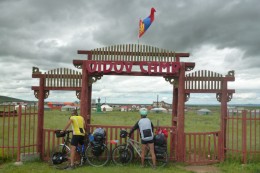
But that's less important to us right now. In order to reach the planned camp (also one station in 2013), we would have to drive 7 km north (towards the airfield) through the terrain. But the headwind has really got to us, so that we lack the motivation and simply want to use something closer. Directly opposite the gas station there is a big wrestling monument to be seen. Beside it there are yurts. It doesn't look like there are tourists here, but we'll try it. And as always one answers with: "бoлнo, бoлнo" - means as much as "yes, yes - already goes". Today there is nothing with a shower, but they bring us a plastic barrel with water and a bowl. And we can even order a dinner. So - the essentials are settled.
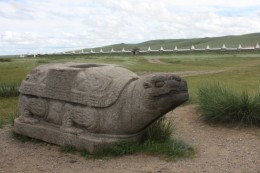
We still have some time until "dinner", and we use it for a visit to the Erdene Zuu monastery (German: "Kostbarer Herr"). On the one hand it is a museum, on the other hand since 1990 in a part of the area there is again "normal" monastery activity. A wall with 108 stupas encloses an area of 400 x 400 meters. If one leaves the site through the opposite gate, one gets to the area of the old town Karakorum. But there is nothing more to see. Only a big stone turtle remains as a witness from Chinggis Khaan's times. Excavations are documented next door.
The wind has turned again. Towards Ögii Nuur it comes from behind. It will be a very relaxed stage. With bright morning sun we cross again the Orkhon valley on endlessly long dead straight road. There is high spirits again. A large part of the Orkhon Valley has been a UNESCO World Cultural and Natural Heritage Site since 1994.
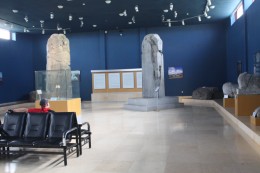
The relatively narrow, but good asphalt road was built with the help of Turkey and leads directly to a memorial site commemorating a Turk empire in the 7th/8th century. Huge stone tablets with ancient Turkish writing were found here. Probably the oldest in the world. The exhibition is worth seeing. We are also not the only guests.
Then it doesn't take long and the asphalt road turns into a steppe road. But the wind is with us today and everything is only half-as wild. Gradually it gets mountainous. When the steepest spot has been climbed, the view opens up to Ögii Nuur.
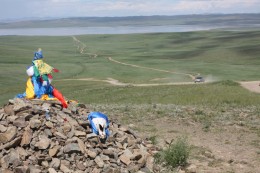
There's, like, 6 km to the lake. The view is fantastic. At the bottom you somehow think of a waterhole in Africa. Everyone is gathered here and everyone is allowed to meet his needs - man and cattle alike. But there is enough space and you don't get in each other's way. We have a good time in the race, the camp is ok, and we take the chance for a swim in Ögii Nuur. The lake is relatively shallow, the water pleasantly warm. There won't be such an opportunity again.
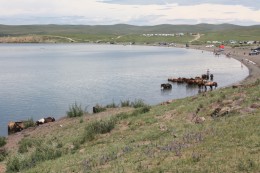
Thus the westernmost point of the tour is reached. The next stages lead in a fairly straight line back to Ulaanbaatar. The ruins of a fortification near Dashinchilen should be mentioned as a cultural contribution. There is an exhibition room that can be visited for a small fee. But much is not to be taken from the documents. The Trescher travel guide says that these are buildings of the Khitan, Mongolian tribes that had their heyday in this area from the 7th to the 12th century. The accuracy of the piled stones is impressive. It is hard to believe that the ruins are so old.
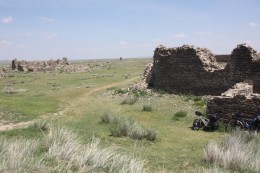
Also worth mentioning is the Ger-Camp Chirimiin Tsagan Nuur. It is a bit away from the tourist highlights, just like that in the steppe. But we liked it there very much. One takes care of the tourists and also sanitary everything is exemplary. Here the coordinates: 47.9422 N, 106.1345 E. The camp deserves some advertising.
And then the "Khuushuurbude" at Emeelt has to be appreciated. It stands on the right at the street (UB out of town) at the foot of several Owoos, before it goes down to the village that actually still belongs to the urban area Ulaanbaatar. Already on the outward journey we stopped here. "Хyyшyyp" is perhaps what the Bockwurst or Bratwurst is in Germany. There is the opportunity for this pretty much everywhere. Khuuschuur are fried dumplings filled with meat (mostly sheep). If they are cooked, it is called Buuz. It tastes good - one can recommend it. Here you can also get Airag (fermented mare's milk) - but let's wait a little longer. To be on the safe side, we try it towards the end of the tour.
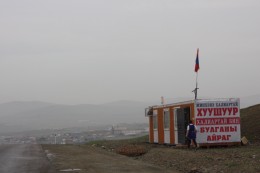
For the renewed, temporary stay in Ulaanbaatar we had agreed on a rest day. We still have a reserve day. But then it comes differently. When we reach the city we get caught by the 11th ASEM Summit, which takes place in Ulaanbaatar on July 15th/16th 2016. Using the free Internet on the airport is impossible: The area is completely closed off, no access without a valid ticket.
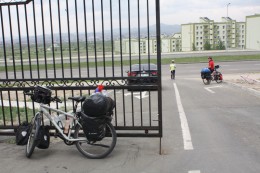
On the wide access road to the city centre we will be taken out of traffic for the first time. There is another delegation passing in convoy. Of course this has priority. There are 51 countries and two organisations represented at the ASEM Summit - that can be cheerful. We stay on the (downstream) left side of the Tuul. According to Google Maps, there are some Ger camps there. We want to take one of them. But this will be a mistake at the end, because on the left side of the Tuul there is also the ASEM village - as we will notice later. As a result, the road is closed frequently.
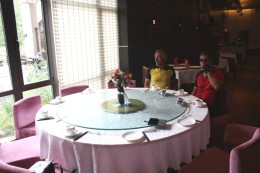
In the beginning everything is still quite amusing. The police waves us directly to the premises of a luxury restaurant. That's closed, of course. But the concierge holds the position, opens the restaurant for us and says, we should make ourselves comfortable. Of course, there is no service and everything is locked, but we are on the way with the gas cooker. It's time for a good cup of coffee - the table is already set. For the caretaker and the policeman, we'll join in right away, which leads to the fact that the strict view of the state power so far brightens up a bit. After about an hour we are allowed back on the road. But after about 500 meters it is already over again and we are taken out of the race again and taken to a Ger Camp. That is actually what we are looking for. But they tell us right away that there is no shower here. There is enough time for a beer in the restaurant.
We have to take the next camp. At the gate it says "Closed" and the police have occupied it. But then an older man approaches us and waves us in, immediately unlocks a yurt, and we are already sitting on the edge of the bed - meanwhile surrounded by two other men who are his brothers. One even speaks a little German. We already notice that they are all a little energized. But somehow we can't get out of the situation. After we've paid, the boss has immediately spent part of the money and comes back with a bag of beer cans and a bottle of vodka. At this point I stop with the description...
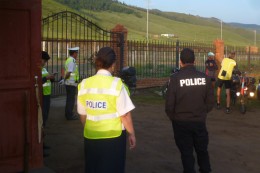
Well, we survived. But the rest day tomorrow is cancelled. We have to see that we get away from here - because of the three brothers and because of the ASEM summit. But they are not letting us out on the road. The first information: it will be at 8 o'clock. The second information: You can leave at 10 o'clock. The third information: Now only the Portuguese are missing, then the road is free. But the Portuguese seem to take their time for breakfast. Then finally they have also passed.
In the "South" - south of UB
It's southbound. But first we pass the "ASEM-Village", even if only at a great distance. Although not much is to be seen, a few photos must be. It is built on the area of the ski center.
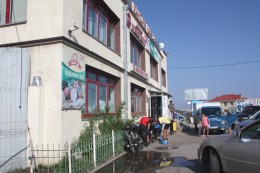
Before we leave UB completely, we quickly go shopping again. We just stow away our provisions, when two dark limousines stop. Men in civilian clothes get out, identify themselves as security guards and demand our passports - all correct and friendly. And then they want to see the photos we took of the ASEM area. There is not much to see, but nevertheless we have to delete them. Discussing doesn't help much - they have their instructions. At least they still ask us if we like it in Mongolia and wish us a good journey. Who knows, maybe they were bored, and we came just in time.
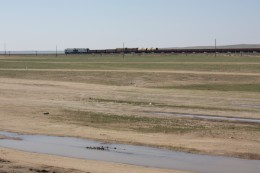
It goes now once again direction Nalaikh - on a kind of "Plattenstraße". Then follows a piece of already known road. At the junction to Zuunmod we drive straight ahead this time. It gets a bit mountainous, but the wind is good and the temperatures are bearable. We make progress. Sometime the hills are over and it is only flat. The vegetation gradually becomes sparser. To the right of the road runs the railway line to China. The track is single-track and the trains we see during the day can be counted on one hand.
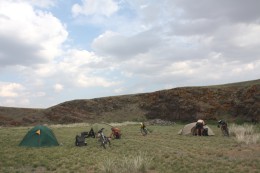
We don't have a real daily goal. It is too far to Tschoir for today. Since the wind is good, we want to drive as long as possible because of the late start. The landscape is quite monotonous anyway. At some point we look for a place for the tents - not too far away from the road. There are 90 kilometres left for tomorrow - that shouldn't be a problem.
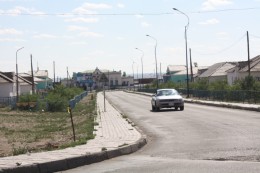
Tschoir is the "provincial capital" of the Aimag Gobi-Sumber. About 8000 people live here. There is not much to see. In former times, in socialist times, it was a location of the Soviet army. But hardly anything has remained of it. Tschoir has a certain significance from a traffic point of view: trains always stop a little longer here. Perhaps they will refuel. Behind the railway tracks you can see a gas depot. There is a hotel in a block of flats, certainly also from earlier times. But the rooms are quite acceptable. Sanitary is on the floor, it works.
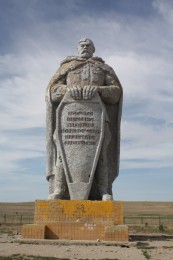
Before the steppe stage to Darkhan we have another rest day. We explore the former military area. What has remained is a huge soldier monument with the inscription "Бсе что создано народом должно должно быть надежно защищено". That has already something impressive. The rest was leveled apparently. In Tschoir itself there are some good asphalt roads and also some bigger buildings. The most beautiful is probably the station. We decided to go back to Tschoir from Darkhan and take the train to Ulaanbaatar. So we are on the safe side. For the day before the return flight we have an invitation to dinner from a friend of Chuugii's uncle. Otherwise everything could be a bit tight.
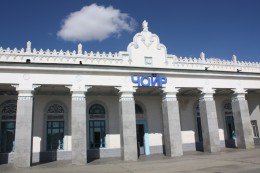
So we take a look at the train connection and are astonished: Every day there are exactly two trains to UB that we can use. The international trains Peking - UB are apparently taboo. The first one comes from Sajnschand, the provincial capital of Ostgobi Aimag. Departure from Tschoir is 2:25 am. The second one comes from Dsamyn Uud, which is on the Chinese border. Departure in Tschoir is 4:28 am. Well, we'll probably have to spend the night at the station later on.
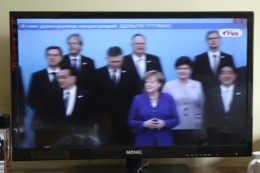
It should also be mentioned that there are relatively good sports facilities in Tschoir: Skating rink, basketball court and a super football pitch with artificial turf. It would be interesting to find out if there is a football team here and if so, against whom they play. The rest of the day consists of playing skat and watching TV. The programme includes the European Football Championship, sumo wrestling and the ASEM Summit. Old faces are also there.
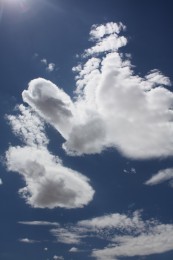
The road from Tschoir to Darkhan is part of the direct connection of the Aimag centres Tschoir (Gobi-Sumber) and Öndörkhaan (Khentii) - nevertheless there is only a steppe road. The distance to Darkhan is 95 kilometres, and there are some "washboards" and sand sections. But the wind fits. We are optimistic that we will make it. In addition, the navigator wants to meet us by car and possibly take some of our luggage with him. But as it is: We have to wait for him. Seems like we must have missed each other. But today we are in a good mood, the weather is perfect, the landscape is great, the clouds are a work of art.
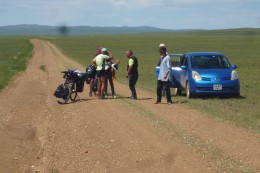
At a certain point we'll be caught from behind. There they are! We actually missed each other. The joy is great. They brought us Khuuschuur. First we have a picnic. Since things are going so well today, we don't give any of our luggage either. If we reach Darkhan without outside help, then the tour is actually over. Everything else is just a bonus.
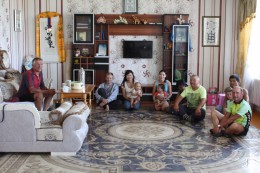
So we drive on to Darkhan and from there another few kilometres to the northwest. At Chuugii's brother Batbold we meet again. He has reconstructed an abandoned building of the Soviet army into a residential house. It's not quite finished yet, but it has big rooms. We move into one of them for two nights. There is first of all a welcome tea and some pastries. A good opportunity for a photo together.
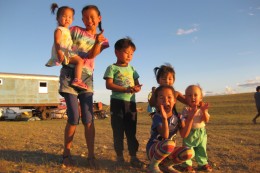
For the evening we are invited to Chuugii's parents, at the moment they have their "camp" another 7 kilometres northwest. There is a construction wagon. The ger of the "Europeans" was built next to it. The navigator with his family stays a few days longer than we do in Mongolia. There is "Cүүтaй Цaй" (tea with milk), Tsuivan (homemade noodles with dried beef) and Airag (fermented mare's milk), which has succeeded very well.
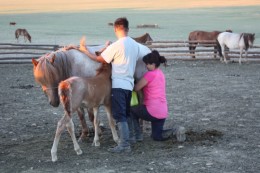
It's not that Airag is always in stock - it's something for special occasions.
Then of course all the children and grandchildren are there. It is quite a jumble. I receive a Deel (the traditional garment of the Mongolians) as a present, which I put on immediately. Then follows a riding lesson for the cyclists. Chimgee and Ragchaa (Chuugii's brother) give a demonstration in mare milking. We taste the milk - it tastes sweet. However, it has a strong laxative effect. Only through the fermentation to Airag it becomes edible for humans.
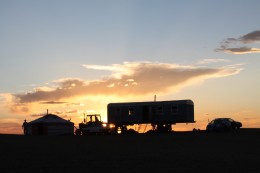
We'll come back to our lodging in the dark. Tomorrow is Naadam Festival in Darkhan.
Brief information about Naadam: Correctly it means "Eriin Gurwan Naadam", which translated means "The three male games". These are wrestling, archery and riding. Riding is probably the most important sport among the spectators. The riders are all children. Since the whole thing is not harmless, because there are serious accidents every year, Mongolia is therefore somewhat criticized by UNESCO.
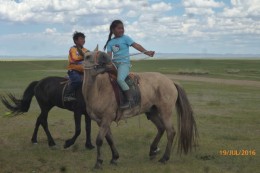
But when you see the children - the routine with which they have their horse under control - then they would certainly be the last to understand if they were forbidden to do so. It's not just a sports competition, it's also a cultural heritage. Of course, the girls also ride, and the women also take part in archery. Only wrestling is a man's business - not least because of the somewhat peculiar wrestling clothes.
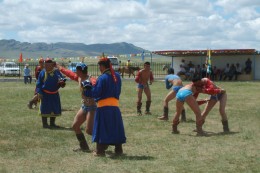
We're waiting for the navigator to stop by. He wants to take us with him. But time passes and nothing happens. At some point the information comes that there is a problem. In the night the cattle herd (sheep, goats) mixed with the herd of the "neighbours" at the waterhole - altogether about 3000 animals, and now they have to separate them again. Naadam is of secondary importance at the moment.
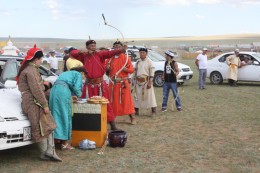
Chuugii's uncle Buyan also came to Darkhan with his family from Ulaanbaatar. He takes us with him. We didn't really miss anything of the programme: The opening should be at 11 am. But somehow it is postponed. There were probably too few interested people: They were all already at the first horse race. We just arrived at the finish line. Meanwhile, at the wrestling the last fights of the first round have just ended.
Chuugii's uncle also has a horse in the race today. This - or for whatever reason - makes him one of the few privileged people allowed to accompany the race by car. Of course we are there. The distance is 14 kilometres. But it's first 14 km from the finish to the start and then the 14 km back again in the competition. That's a long edge. Anyone who has experienced the start once and then has driven alongside has the highest respect for what horses and riders are doing. Those who are not at the top ride in a huge cloud of dust.

Only when the field has pulled apart does it become more normal again. Well, Buyan's horse and his rider did well and took a good middle place. Only one can win, but everyone who reaches the finish will be proud to have been part of it.
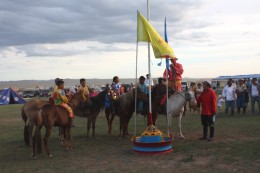
We're kind of observers - looks like the only non-Mongolians. We take a look at everything, sit on the VIP stage for a while and also watch the award ceremony. Organizers have already come up with great certificates, medals and prizes. The resonance at the award ceremony is bigger than at the opening event, which was inserted sometime in between. There was a real cultural program: with horse head violin, songs and folk dance. But nobody really listened. A pity about that.
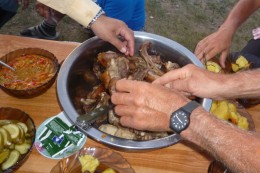
In the evening we have Khorkhog. When it comes to Mongolian cuisine, the following link is recommended: "www.mongolfood.info/de/". They butchered a sheep for us and prepared it traditionally with hot stones, potatoes and other vegetables in a closed vessel. At the end you have a big bowl of meat and everyone cuts off what he likes the most with a knife. It's rustic, but it tastes great.
This brings the stay in Darkhan to an end. To all, which cared for us around the clock "Thank you very much!" or "Их бaяpлaлaa!", as the Mongolian would say.
The next morning we leave early. Soon we realize that it will be a hard job. The wind comes tightly from the front. There's not much you can do about it. Make small and pedal. Fortunately we have time. Our train doesn't leave until 2:25 a.m. tomorrow. About 18 h Tschoir comes into sight. Now it is still 15 km. There are more and more tracks, but none of them is really usable - "washing boards" everywhere. It takes another 90 minutes until we reach the asphalt road again.
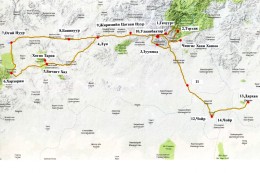
The tour is over. It looks a bit different than the plan at the end, but that doesn't matter. The rest is not worth mentioning. The important thing is that we were in Darkhan on our own. We were assured that we were the first to arrive by bike in the 93-year history of the village. If that is nothing! 
We settle down at the station in Tschoir. The person on duty unlocks the toilet for us (for 200 tugrik per person). We can wash and shave. The bicycles are to be handed in, they come into the luggage car. There are personal tickets with name, car number and seat.
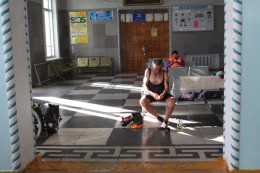
So it could have happened that we could not travel with at all. Because the train is full and there are actually no vacancies. It's a kind of couchette car. But for us it doesn't matter anyway, because we occupy the lying areas with our many bicycle bags. For the approx. 240 km as the crow flies from Tschoir to Ulaanbaatar our train needs five hours. All stations are taken along, and at the end we are even almost on time. So we got a feeling what it means to travel with the Mongolian railway.
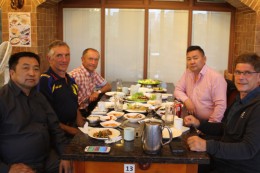
Remains the final dinner at the Seoul Club to mention. Buyan's friend - I know him since the wedding three years ago - has invited. We are taken by surprise: It's a noble address in Ulaanbaatar. Already the five different menus are a bit unusual: Mongolian, Korean, Chinese, Japanese and Western cuisine. Since cyclists are usually always hungry, everyone orders a good portion. But what comes next exceeds all expectations: Giant portions, plus countless small bowls with all kinds of side dishes. It tasted great, but we didn't make it - that's a pity. We should have been given a tip.
Before Buyan drives us back to the camp - we stayed near the airport - we stop by his house. And we have to have another try: Homemade warm sea buckthorn juice and black currant jam. Great. Everything from their own garden, about 300 km north close to the Russian border. Well, this also grows in Mongolia.
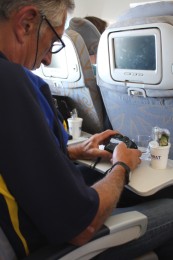
The next morning it rains. But we only have 11 km to the airport. The boxes are still there. Now the whole procedure in reverse order. Punctually 10:15 h the Chinggis Khaan takes off - the position display works again. One is somehow glad to sit again in the airplane, and one is pleased internally that everything worked so well. It's time to click through the photos and draw a first mental summary. Well, we couldn't quite implement our plan - but that's not bad. In any case, we now know what it means to ride a bicycle in Mongolia. The stages we didn't ride are still on the GPS - maybe there will be a new attempt at some point.
Cycling in Mongolia
Mongolia - a large and wide country, very different from the narrow Europe. If you come by plane, you are right in the middle of it. That impresses. Of course, this grandiose landscape also has its problems. On the one hand it is the great distances themselves, on the other hand the extreme climate - little water, for weeks temperatures around minus 20-30 degrees in winter. And then, of course, there is the garbage problem - like everywhere else in the world. When is it worth investing in infrastructure? Does some technical progress make sense here at all? Comparisons can only be made to a limited extent. Different environmental conditions simply produce different forms of life.
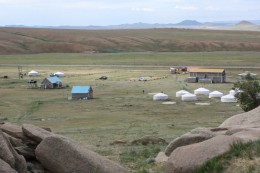
Overnight Stays
Mongolia is not a holiday destination in the classical sense. Apart from a few exceptions, Mongolia is not geared towards tourists. Nevertheless, strangers are welcome, and we have never experienced that we were rejected in the search for an overnight accommodation. Of course, one should not expect to find a shower. A bucket of water and an outhouse is what is almost always possible. In the Ger camps one has usually shower and WC. This is about comparable to a camping site in our country. With hotels you have to be careful - best not to expect too much. That one in Tschoir was quite ok. But that was also our only hotel. So we can't really say anything about the topic.
Catering
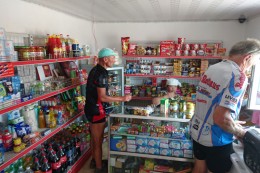
The supply of food on the way is actually not a problem. There are supermarkets only in Ulaanbaatar, smaller self-service shops perhaps in the Aimag centres. Usually one is dependent on the "Xүнcний Дэлгүүp", which means nothing else than "food shop". We would call it "Aunt Emma's shop". But they do have what is needed: Water, bread, sausage, milk, pickled gherkins, waffles, biscuits... Gas cartridges... Peanuts, beer.  Of course, green stuff is rather rare. But sometimes there were apples or tomatoes. The opening hours often go until 22 or even 24 o'clock, and Sundays and holidays are no reason to close.
Of course, green stuff is rather rare. But sometimes there were apples or tomatoes. The opening hours often go until 22 or even 24 o'clock, and Sundays and holidays are no reason to close.
Road Traffic
One often reads in travel reports that there is no consideration for cyclists by the motor traffic. We expected the worst here. But in the end we have to say that we never had the feeling to be exposed to any danger. Maybe it was because the traffic outside the capital is not too dense in terms of road width. Often people honk their horns to draw attention to the danger or even just out of sympathy. The main roads to the right usually have sufficient clearance for an emergency stop. On the steppe tracks this topic is unnecessary, since nobody is bound to the way. The locals still warned us against drunken drivers, especially because of the Naadam time. But luckily we didn't get to know any of them, or maybe we just didn't notice.
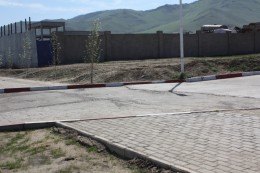
You shouldn't expect bike paths. In Ulaanbaatar, in the course of the extension of the road from airport to city centre, a kind of cycle path has been built, but nobody will ever really use it: On the one hand, there are mostly concrete blocks laid, which gets hoppy with time, on the other hand they are usually not lowered at junctions. This actually only proves the assumption that bicycle traffic has so far played virtually no role in the thinking of city planners.
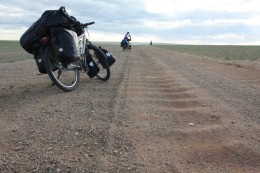
Material
On the second day we got a bit scared already. The worst roads are gravel roads, which partly disintegrated in the course of time, and stones like wedges sticking out of the compound. This is followed by the "washboards", which are formed relatively quickly in the steppe, and finally the sand pits. In the beginning we thought it was only a matter of time before the first damage occurred. But then the tour was over and nothing happened. So, great praise for the bicycle manufacturers. Of course we were only on the road for 3 weeks and only about 350 km off-road. But always with full load. Dust and dirt are of course a topic. We continuously oiled the chain for three weeks without cleaning it properly. It worked. I don't know - maybe it's better to clean it properly from time to time, but that's easier said than done without the necessary utensils during the journey.
Dogs
The dogs in Mongolia are rather of the larger type. Experiences from 2013 have shown that they can be quite aggressive - at least towards cars. I had therefore been vaccinated against rabies as a precaution. This is paid for by some health insurance companies, but not by others. All the more surprising then the experiences on the ground. There were absolutely no problems - with one small exception, but the lady of the house immediately provided clarity. Otherwise, all the dogs we met were quite tolerable - quite different from the Balkan in 2012. However, they probably dislike cars. Somehow they don't like them. Maybe only because they move so fast.
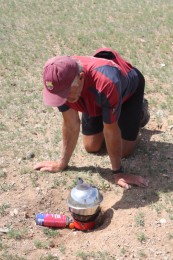
Environmental conditions
We were travelling in July. This is the "rainy season", in theory at least. The weather is then comparable with Central Europe. We had 38 degrees in the shadow, which is usually not there - but that was only one day. Otherwise the temperatures were rather moderate. To the missing shade comes the merciless wind - there are generally no natural or artificial obstacles. And when it comes from the front, it becomes difficult. In this respect, a tour like the one we had planned, with a fixed target date, is actually not the right approach. But because we were never more than 400 km away from Ulaanbaatar, in an emergency we would surely have found someone to take us back to the capital with the transporter that usually drives the horses. In this respect, that was also predictable.
Language
You should bring some Mongolian knowledge with you. English doesn't help much. Maybe you can get to grips with Russian with older people. It is definitely worth investing some time in the language. People are usually surprised that someone tries to speak Mongolian and they always acknowledge it with a smile.
Conclusion
It's not like they don't ride bikes in Mongolia at all. In UB you see someone riding a bike from time to time, and in the country it is mainly the children who own a bike and somehow maltreat it. But to be on the road with full luggage is something special. If one meets oncoming traffic in the steppe, then there are actually only two basic reactions: Usually you are greeted with an appreciative nod of the head, sometimes even cheered and applauded, but sometimes you meet a look of pure horror in the sense of: "What kind of people are they? Why don't they take a car or at least a horse? An argument that it is not so easy to refute. 
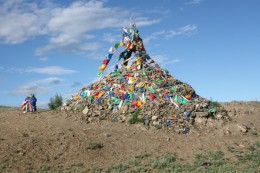
As a newcomer you are overwhelmed by the wide country. This relativizes itself with each day and with head wind the "wide country" can become also fast the source of frustration. But the next day the wind may have changed and the world looks much friendlier again.
The aim of the tour was to gain some experience. Is it possible as a person without a "globetrotter mentality" in a country without the usual infrastructure to travel by bicycle for a longer period of time? Yes, you can. It's a question of attitude. If you limit your ideas of comfort to what is necessary and then eliminate the time factor - so it doesn't depend so much on the exact plan - then a Tour from Dresden to Ulaanbaatar seems quite feasible. Because what works in Mongolia will also work in other countries: If you practice modesty and don't consider yourself to be too important, but instead acknowledge and respect the environmental conditions and the living conditions that have developed from them; if you try to speak the language of the country, you will always find people who are benevolent and willing to help you being the exotic.
Who wants to know now still more exact, can turn as always to oldi@tour-d-europe.de.
Manfred Rahmig



